August 17 & 18

Today's mostly a snapshot day. Tony and I have come out of the park and back to Maun to meet our students. We have a full house, as usual, with 12 students rambling into the Royal Tree Lodge today. Okay, not quite. A couple of students got here yesterday while we were still in the field, and one had a flight into Jo-berg that missed the connecting flight to Maun, so he won't arrive until tomorrow. Still, it's workshop time, and we've got a lot of work to do before we head back out into the park.

First up was doing as much of my usual teaching presentation as possible. Let's just say that triangles are involved (former workshop students will know what I mean, the rest of you will have to wait a bit to know what that's about). I try to get everyone thinking about the photographic decisions they'll be making in a useful and interesting way, and both Tony and I will follow up on this on Day Two with presentations on how to apply that to safari shooting.
It seems, however, that every time I do this presentation, it gets longer ;~). It originally started as a two-hour presentation, and these days it's difficult for me to get it all done in four. No, I'm not slowing down; I'm adding more detail and emphasis on the points I make. And, no, I didn't make everyone sit for four hours listening to me bloviate: we went for a bit less than two hours mostly centered on composition.
It turns out that we have some interesting students, too. When I got to a section where I talk about eye movement, it turns out we have someone who studies brains and knows the research behind what I was talking about. So I'm pretty sure we're going to have some interesting discussions at camps during the next weeks.
After everyone fell asleep listening to me we had a nice dinner.
I'm always happy when I get to Royal Tree Lodge. First of all, it means that all the plane trips are done (for awhile). But more importantly, it's a very pleasant little oasis just far enough away from dusty, chaotic Maun, and the staff is not just friendly, but really do seem to want you to enjoy yourself. The accommodations are nice (as long as you remember to keep your Monkey Lock on the door latched), and the food is plentiful and good.
After a nice welcome dinner we had one of the first surprises of the workshop (for the students, that is). Royal Tree Lodge is also home to a family of genets (Carnivora/Feliformia/Viverridae/Viverrinae, if that helps). Every night after dinner they come down into the big tree on the deck of Royal Tree Lodge and hunt for scraps.
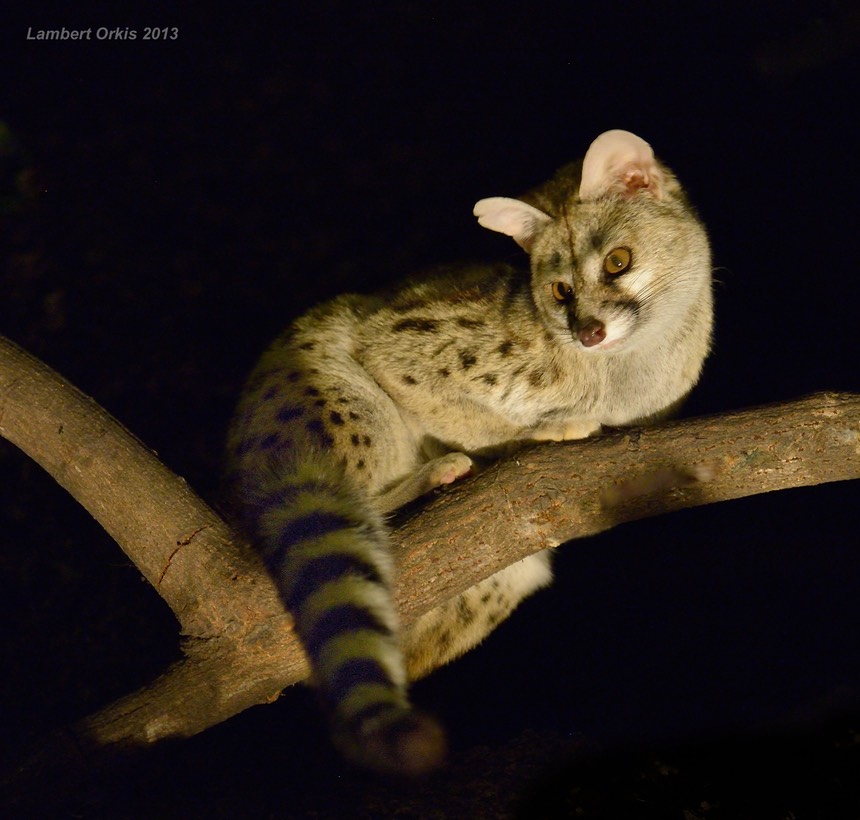
This is always an interesting point in the workshop for me. Some number of students will always get excited by the First Night Genet and if they don't already have their camera handy, will go retrieve it. A few will be trying to relax (after all, this is their first night away from work and airplanes). Almost none will have ever seen a genet in the "wild" before (Royal Tree Lodge is a fenced Game Reserve, thus the quotes), so it's helpful to me to see how excited they are, what questions they ask, and to also see how they go about taking pictures of it in what are decidedly poor conditions.
In these first two days, I'm definitely in full teaching mode: observe, listen, respond, prod, encourage, lecture, test, help.
This all goes into full Turbo Thom mode on Day Two.
Consider this image:
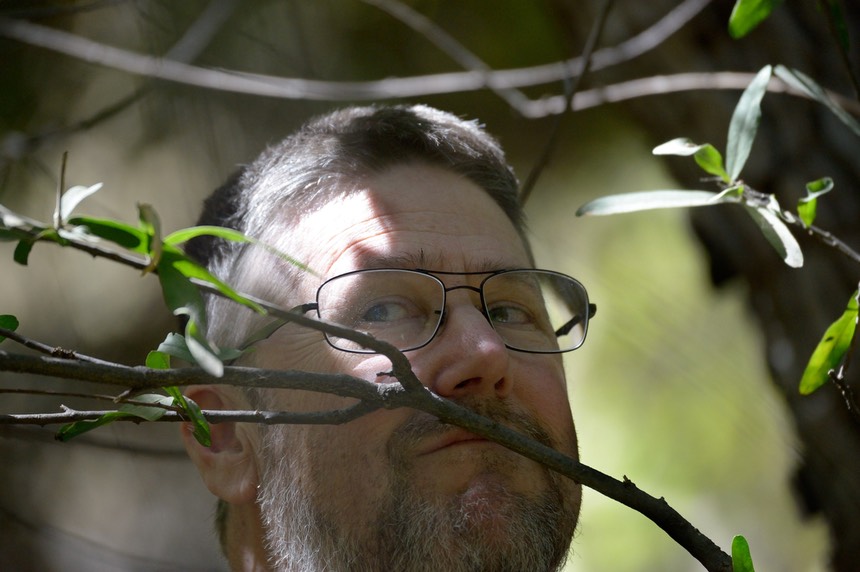
Yes, that's me. But what am I doing behind those branches?
Well, this is part of some autofocus practice sessions. Tony and I split the students up so we can see how they're handling their cameras and focusing on moving objects (note I was actually looking to see what someone else was doing, not this shooter). Moving objects that constantly dart behind trees and trigs and grass and termite mounds. Ah, so that's why I'm behind the branch. But I didn't last long there. A few seconds later I was running across the lawn to some other location, doing my best frightened impala imitation (I think I may have even let out a warning snort).
It doesn't take long in doing this to observe who's got good habits and who has habits that need to fixing. Also, I keep chimping everyone's LCDs to make sure the pictures they are getting are actually in focus. No? Then we need to figure out why focus was missed. It's actually amazing how fast you can start dialing people in with just a little bit of play like this. Besides, I need the exercise from all that running around.
After dealing with some basic handling and focus scenarios with everyone, we again split the group, with Tony working on trying to AF Fine Tune everyone's camera/lens combos while I started working with individuals on specific things I had noticed and giving them little tests to make sure they were ready for the spontaneous things that'll happen once we're on safari.
Unfortunately, the beta software I had brought to "auto" tune cameras didn't work, so we ended up doing a lot of manual tuning, which meant I had to come over and look at the computer monitor a fair number of times and make judgment calls. As usual, some camera/lens combos didn't need anything, a few needed a lot of tuning, and some just needed some tweaking. There really doesn't seem to be any rhyme nor reason to what I see with large bunches of Nikon gear: there's no nice bell curve that everything tends to bunch up in. We had four D800 plus 200-400mm combos that were basically all over the map. Ditto all the D7100's and 500's and 70-200's and 80-400's. Overall, there were only a few camera/lens combos that didn't need something in the AF Fine Tune value, which is the same result I see at every workshop.

Thom checking an AF Fine Tune setting (Tony's in the background generating a new set)
Let's see, what else?
Well, we had the ritual bean bag filling, of course. Three huge boxes with bags of corn were quickly swallowed up by the Gura Gear and other bean bags that people had brought. As it turned out, my calculations were right on: we filled the last bean bag with the last bags of corn. I think this was just luck, not any skill in estimating on my part. Adam was ready to head back to town and buy more, if need be.
Think we're done? Not even close.
Tony had his presentation on the animals we'll be dealing with, what we're looking to photograph, and the problems that will come up in trying to do that. Every animal poses a different set of problems you have to deal with. Then there was my presentation on how to incorporate the compositional things I talked about the previous night when it comes to the problems the animals present you. Remember, we can't always move our position relative to an animal and you might be using a fixed focal length 500mm lens, so you definitely get compositional challenges that have no perfectly clear answer. I like to start talking about that before we encounter them in the field.
And it's now time for lunch…wait, you thought we were near the end of the day? Nope. I told you it'd be packed and I'd be in Turbo mode.
After lunch we've got two new goals to reach. First, I want to work with every student one-on-one for at least a short period of time in order to walk them through compositional decisions, even if it's on still life subjects around the lodge.

That backlit green leaf provoked a lot of attention during this assignment, but there were a lot of other things around the lodge that attracted our students and led to the type of compositional decision making dialog that I was trying to provoke and step through. The object of this exercise isn't to take great pictures around the lodge (though that's possible), it's to get everyone thinking about composition in a more structured, practical approach that's repeatable. What I find with most amateurs (and even some pros), is that their compositional development is completely spontaneous and unstructured. There's nothing wrong with being spontaneous, but the unstructured part means you have no repeatability in what you do. Some of your compositions will be good, others mediocre, still others bad. There's little chance that you can develop a "style." More often than not, mimicry—trying to get the same image that they've seen from someone else—is the only clear repeatable thing that is done in composing. But as I point out in my lectures and teaching, if all you ever do is mimic others and use rule of thirds as your only compositional guideline, there's only a limited number of pictures that can be taken in the real world, and they've already been taken by others.
Most of the family and friends of the students (and even Tony and I) will never travel to Botswana. You could bring back pictures they could see elsewhere (e.g. Frans Lanting's book), or you could bring back something they couldn't ever see elsewhere because it's unique to you. Which is preferable?
The other thing we needed to do this afternoon was get everyone ready to shoot from the vehicles.
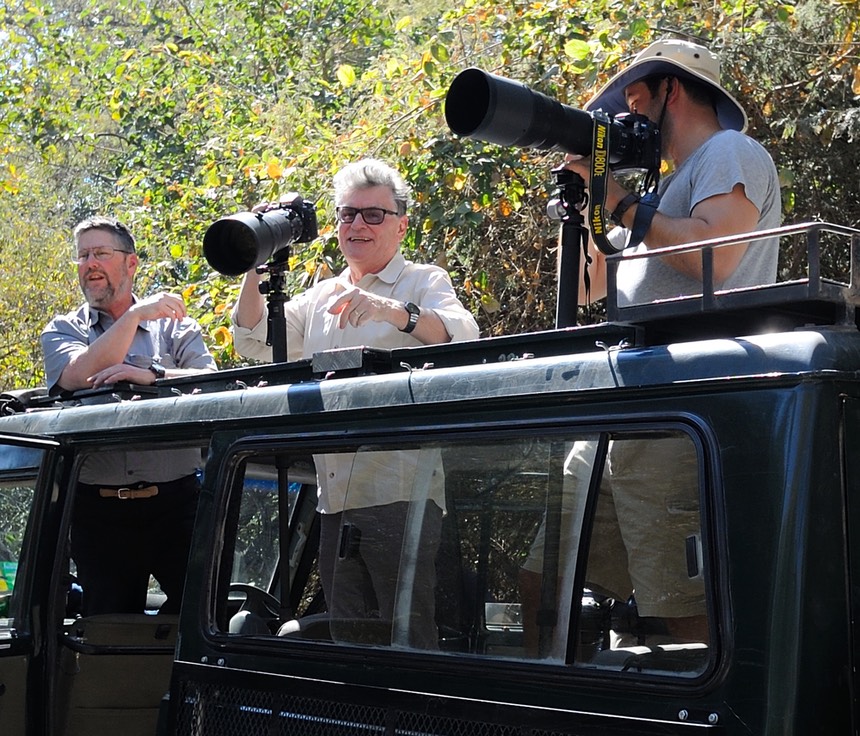
We had two of the Land Cruisers available to us (technically, I could have asked for all of them, but there's only Tony and I to split between vehicles and help people, so two time-shared vehicles makes more sense). Remember, Royal Tree Lodge is actually a fenced animal preserve, complete with a set of roads snaking through it, and a reasonably healthy population of various antelope, zebra, giraffe, and a few other of the non-carnivores (obviously, you don't want a carnivore in a fenced in area, otherwise you'd end up with no non-carnivores eventually ;~). In the image above, I'm talking through some of the particulars about what you can do when standing in the vehicle and using a monopod with two of the students. After quickly demonstrating the options—and there are a lot of options in shooting from these vehicles—Tony and I each took three students at a time through the preserve to simulate what would happen on the main safari and work with each student to get optimal steadiness from each of the possibilities for shooting. Fortunately, the animals cooperated this time (last workshop they were all hiding somewhere on the property away from the roads), so we were able to quickly get people dialed into better habits for shooting.
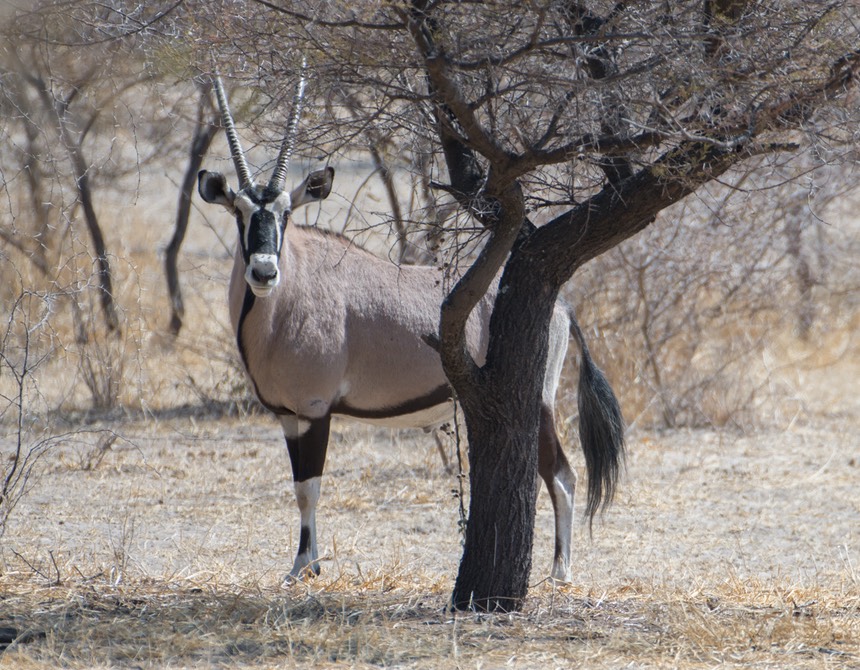
I'll take this moment to point out something that both Tony and I observed throughout the workshop: while everyone was doing the right things after we stopped, the students seemed reluctant to heed one other bit of advice, which is that you really have to be ready to shoot before the vehicle stops. This is a tricky thing, and one that's tough to put into practice.
Let's say that you're driving along and you see a honey badger up ahead digging in the dirt. If you wait until the vehicle stops before getting into shooting position and bringing your camera up with you, this is the first shot you'll get:
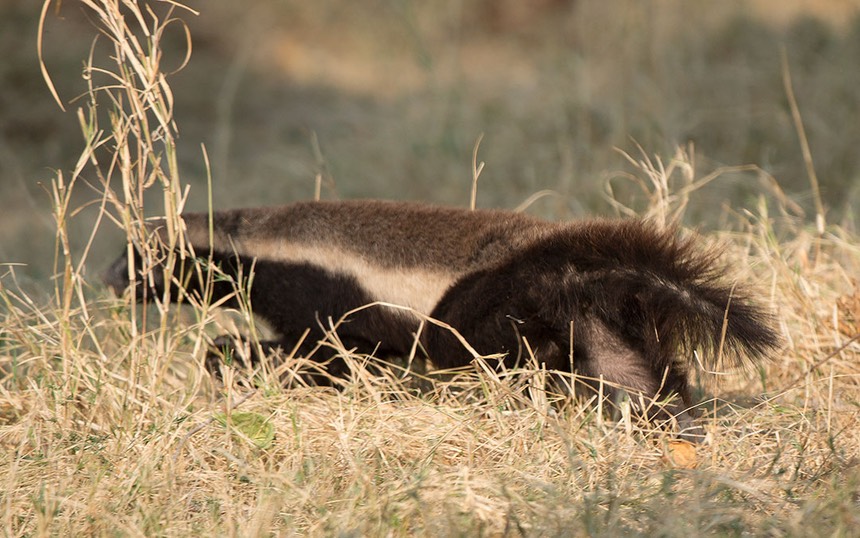
The animal is already running away from you and disappearing into a protected area. The classic butt shot, at best. Sure, you might get lucky and find a more cooperative animal that stays put, but basically you want to be ready to with your finger at the shutter release and the camera aimed the moment the vehicle has stopped (and sometimes even before it has, though this is really, really tough to get steady). If you wait until the vehicle is stopped to then pick up your camera, then move your body and camera into a shooting position, then try to figure out your settings and finally acquire a focus, you've given the animal many seconds to decide to move away. Many animals tolerate you driving by just fine, but they get a little paranoid when you stop.
Of course, there's a danger with getting ready early, which is why a lot of non-pros don't attempt it: your equipment and body are at risk. I often come back from these trips with a few bruises where a last minute jolt as we stopped banged me against the frame of the roof opening, and it's very easy to bump your gear against the metal parts of the vehicle. Still, it's worth finding ways to minimize those risks and maximize your shooting potential. Rarely does anything stand still in the wild for long. Thus, at a minimum, you should know that you've already got a good exposure set, the right ISO set, your focus settings where you want them, your camera in your hands ready to bring up to the eye, and anything else you can do to minimize the time from stop to shoot.
Since I tend to use a window mount from my low front seat position (avoids me standing up into a student's shot), I've usually already made sure that the gimbal is on the right side, the clamp is open, and my camera is oriented with the lens toward the window and the body angled so that it will just slip right into the mount. I'm fairly quick at getting everything up and locked down, and if the road isn't too bumpy or we aren't going too fast, I sometimes am already trying to mount the camera before we stop. If we've been crawling around trying to find a good angle to something, my camera probably didn't come off the window mount at all.
As I noted, we got a fair amount of safari practice at Royal Tree Lodge in the Land Cruisers, and by the time we were done I was comfortable that everyone knew what their options were in the vehicle for shooting and how to take advantage of them. Heck, there was even one antelope at Royal Tree Lodge that we photographed during our practice that we never saw in the wild.
Everyone's back to their cabins early tonight: tomorrow we start the exciting part of the safari, and we want to get an early start.